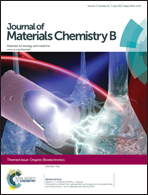Tailored polymeric membranes for Mycobacterium smegmatis porin A (MspA) based biosensors†
Abstract
Nanopores based on protein channels inserted into lipid membranes have paved the way towards a wide-range of inexpensive biosensors, especially for DNA sequencing. A key obstacle in using these biological ion channels as nanodevices is the poor stability of lipid bilayer membranes. Amphiphilic block copolymer membranes have emerged as a robust alternative to lipid membranes. While previous efforts have shown feasibility, we demonstrate for the first time the effect of polymer composition on MspA protein functionality. We show that membrane–protein interaction depends on the hydrophobic–hydrophilic ratio (f-ratio) of the block copolymer. These effects are particularly pronounced in asymmetric protein pores like MspA compared to the cylindrical α-hemolysin pore. A key effect of membrane–protein interaction is the increased 1/fα noise. After first showing increases in 1/fα behaviour arise from increased substate activity, the noise power spectral density S(f) was used as a qualitative tool for understanding protein–membrane interactions in polymer membranes. Polymer compositions with f-ratios close to lipid membranes caused noise behaviour not observed in lipid membranes. However, by modifying the f-ratio using a modular synthetic approach, we were able to design a block copolymer exhibiting noise properties similar to a lipid membrane, albeit with better stability. Thus, by careful optimization, block copolymer membranes can emerge as a robust alternative for protein-pore based nano-biosensors.

- This article is part of the themed collection: Bioelectronics

 Please wait while we load your content...
Please wait while we load your content...